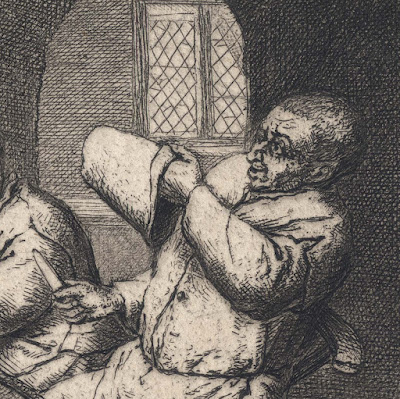Adriaen van Ostade (1610–1685)
“Knife Fight” (Le coup de couteau
[Barsch title]) (aka “The Fighting Cardplayers” and “The Peasants’ Quarrel”),
1653, published in Haarlem. This impression is from an edition printed in the
1700s.
Etching and drypoint on fine laid paper trimmed
along the platemark/imageborderline and backed with a support sheet.
Size: (sheet) 12.6 x 14.5 cm
Inscribed on plate below the image
borderline: (lower left) "Av. ostade. 1653”
State v (of viii) S William Pelletier
(et al) (1994) in “Adriaen van Ostade: Etchings of Peasant Life in Holland’s
Golden Age” (exh. cat. Georgia Museum of Art) advises that in this state “the
left window pane clearly outlined” and “Godefroy described this state as ‘rare’”
(p. 103).
Regarding later states, this impression
does not show the horizontal “U” shaped stroke in the lower right background
floor of state vi (as may be seen in the BM impression of state vi [1980,U.1661])
and this impression does not show wear to the plate of state vii (see the further
elbow of the standing figure on the left in the state vii impression held by
the Rijksmuseum [RP-P-OB-12.675]).
TIB 1.18 [v] (359) (Leonard J Slatkes
[ed.] 1978, “The Illustrated Bartsch: Netherlandish Artists”, vol. 1, Abaris
Books, New York, p. 336); Davidson 18 v/viii; Godefroy 18 v/viii; Boon-Verbeek
18 v/viii; Hollstein Dutch 18-5(8).
See also: Peter van der Coelen 1998,
“Everyday life in Holland's Golden Age: The Complete Etchings of Adriaen van
Ostade”, ex. cat. Rembrandthuis, Amsterdam, p. 112–3, cat .no. 18
The Rijksmuseum offers the following
description of this print:
(transl.) “In an interior of an inn, a
man jumps up from a stool and swings menacingly with a drawn knife, his
opponent shrinks back in alarm and holds his hat in defense. A seated man tries
to calm the angry man and a woman protectively wraps an arm around the child on
her lap. The reason for this fight is a card game that is on top of a [barrel] that
falls through the tumult.”
See also the description of this print by
the British Museum:
Condition: crisp, well-inked and
well-printed impression trimmed along the platemark/image borderline and backed
with a support sheet of archival (millennium quality) washi paper. The sheet is
in excellent condition (i.e. there are no tears, holes, folds, abrasions,
stains or foxing).
I am selling this rare scene of a 17th
century knife fight for AU$376 in total (currently US$275.66/EUR237.10/GBP214.63
at the time of posting this listing) including postage and handling to anywhere
in the world.
If you are interested in purchasing this
wild scene of brawling peasants executed by one of the truly great masters of
the 17th century, please contact me (oz_jim@printsandprinciples.com) and I will
send you a PayPal invoice to make the payment easy.
This print is reserved pending confirmation about its purchase.
Leonard J Slatkes (et al) (1994) in
“Adriaen van Ostade: Etchings of Peasant Life in Holland’s Golden Age” (exh.
cat. Georgia Museum of Art) offers some interesting insights about this print.
For example, I understand that the theme underpinning this “unusually violent
scene” is intended to “warn the viewer to irarum causas” (i.e. “to flee from
the causes of anger”) (p. 103).
Slatkes explains that “renderings of
this traditional theme [of anger] can be traced back to Hieronymus Bosch”—such
as his depiction of Ira [Anger] in the “Seven Deadly Sins” —and, importantly,
is “related to an old Netherlandish moralizing tradition” (ibid).
Slatkes also links this image of
brawling peasants to Jacob Matham’s series of prints, “The Consequences of Dipsomania”,
especially Matham’s final plate showing “a similar fight apparently caused by a
gambling argument inflamed by strong drink” (ibid). Slatkes points out that one
of Ostade’s early contemporaries in Haarlem, Adriaen Brouwer, executed the painting,
“Fight over Cards” (c1631–35), portraying—as the title of the painting
suggests—a similar scene to Ostade’s etching.
Slatkes advises that the theme of anger—especially
over a card game—was “popular in painting even before Ostade produced this etching.”
In fact, “Ostade himself did a fully signed painting of “Card-Players
Quarrelling in an Inn”, dated 1647, although with full-length figures in a
broader spatial settings” (ibid).










No comments:
Post a Comment
Please let me know your thoughts, advice about inaccuracies (including typos) and additional information that you would like to add to any post.